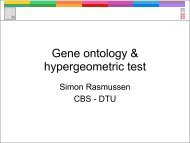Computational tools and Interoperability in Comparative ... - CBS
Computational tools and Interoperability in Comparative ... - CBS
Computational tools and Interoperability in Comparative ... - CBS
You also want an ePaper? Increase the reach of your titles
YUMPU automatically turns print PDFs into web optimized ePapers that Google loves.
Fig. 6 Genomic properties of Streptomyces coelicolor A3. a Comparison<br />
of AT content upstream <strong>and</strong> downstream of all 7,825 genes; the<br />
genes are all oriented <strong>in</strong> the same direction <strong>and</strong> aligned such that the<br />
translation start site is <strong>in</strong> the middle. Z-scores of st<strong>and</strong>ard deviations<br />
from the chromosomal average are plotted, as described previously<br />
(Ussery <strong>and</strong> Hall<strong>in</strong> 2004a). b Codon usage of the same set of 7825<br />
genes. The frequency of occurrence of each of the 64 codons is plotted<br />
<strong>in</strong> a star plot; note that most codons have a relatively low frequency of<br />
usage. c Bias <strong>in</strong> the codon position are plotted as frequencies; note that<br />
seen for many other bacterial genomes. For example, <strong>in</strong><br />
Fig. 7b, there are four large gaps <strong>in</strong> the C. jejuni RM1221<br />
genome compared to other epsilon Proteobacteria. These<br />
correspond to phage <strong>in</strong>sertion sites <strong>in</strong> C. jejuni RM1221, as<br />
described <strong>in</strong> the orig<strong>in</strong>al genome sequence publication<br />
(Fouts et al. 2005). Similar results have been observed for<br />
177<br />
there is a strong tendancy for Cs <strong>and</strong> Gs <strong>in</strong> third position. d Am<strong>in</strong>o acid<br />
usage of each of the 20 am<strong>in</strong>o acids for the entire S. coelicolor<br />
proteome is plotted as frequency of the total; the am<strong>in</strong>o acids <strong>in</strong> this plot<br />
are grouped accord<strong>in</strong>g to their properties; for example, all the aliphatic<br />
am<strong>in</strong>o acids (A, V, L, I <strong>and</strong> G) are together <strong>and</strong>, <strong>in</strong> general, there is a<br />
general trend for this proteome to favour aliphatic am<strong>in</strong>o acids, with the<br />
exception of isoleuc<strong>in</strong>e. The three star plots are as described previously<br />
(Ussery et al. 2004c)<br />
Streptococcus (Hall<strong>in</strong> et al. 2004a). In all three of these<br />
cases, there are large regions which conta<strong>in</strong> many genes<br />
which are miss<strong>in</strong>g <strong>in</strong> other genomes of the same species.<br />
These clusters of genes often conta<strong>in</strong> evidence that they<br />
came from phages, which appears to be an efficient method<br />
of br<strong>in</strong>g<strong>in</strong>g new DNA <strong>in</strong>to a genome.









